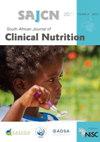Is vitamin D status associated with non-communicable disease risk in children? A cohort study
IF 0.6
Q4 NUTRITION & DIETETICS
引用次数: 0
Abstract
Background: Studies in children and adults have reported variations in 25-hydroxyvitamin D (25(OH)D), body mass index (BMI) and blood pressure (BP) over time. Furthermore, there has been a reported association of 25(OH)D with BMI, BP and lipid levels in some cross-sectional and longitudinal studies. Methods: This is a longitudinal study of a group of adolescents with measurements of 25(OH)D, BP, anthropometry and lipids at the ages of 11, 12 13, 15 and 18–20 years. For age-related changes, year 12 participants (n = 261) were matched with year 18–20 participants (n = 368), resulting in 200 paired participants. Longitudinal analyses using the Generalized Estimating Equations (GEE) comprised the following groups of participants, Year 11 (n = 288), Year 12 (n = 253), Year 13 (n = 292), Year 15 (n = 238) and Year 18–20 (n = 368). The relationship of 25(OH)D with BMI, BP and lipid levels over a period of 10 years was assessed. Results: There were significant increases in mean BMI and BP, and decreases in 25(OH)D levels with age (all p-values < 0.0001). In females, systolic BP was significantly higher in older participants (18–20) years than younger participants (12 years), but 25(OH)D was significantly higher in younger than older participants. In males, there was significant increase in BP in participants between age 12 years and 18–20 years. 25(OH)D, total cholesterol (TC) and low-density lipoprotein (LDL-C) were significantly lower in 18–20-year-old participants compared with 12-year-old participants. Longitudinally, 25(OH)D was inversely associated with LDL-C. Conclusion: There is evidence of changes in 25(OH)D, BMI and BP in adolescents over a period of 10 years. After adjusting for covariates, BMI and LDL-C were significantly negatively associated with 25(OH)D, which suggests that vitamin D status might be associated positively with favourable lipid profiles in children and adolescents.维生素D状况与儿童非传染性疾病风险有关吗?队列研究
背景:对儿童和成人的研究报告了25-羟基维生素D(25(OH)D)、体重指数(BMI)和血压(BP)随时间的变化。此外,据报道,在一些横断面和纵向研究中,25(OH)D与BMI、BP和脂质水平有关。方法:这是一项针对一组11岁、12岁、13岁、15岁和18-20岁青少年的纵向研究,测量了25(OH)D、BP、人体测量和脂质。对于与年龄相关的变化,12岁的参与者(n = 261)与18-20岁的参与者(n = 368),产生200个配对的参与者。使用广义估计方程(GEE)的纵向分析包括以下参与者组,第11年(n = 288),第12年(n = 253),第13年(n = 292),第15年(n = 238)和18-20年(n = 368)。评估了10年内25(OH)D与BMI、BP和脂质水平的关系。结果:随着年龄的增长,平均BMI和BP显著增加,25(OH)D水平下降(所有p值均<0.0001)。在女性中,年龄较大的参与者(18-20)的收缩压显著高于年龄较小的参与者(12岁),但年龄较小的参与者的25(OH。在男性中,年龄在12岁至18-20岁之间的参与者的血压显著升高。与12岁参与者相比,18-20岁参与者的25(OH)D、总胆固醇(TC)和低密度脂蛋白(LDL-C)显著降低。从纵向上看,25(OH)D与LDL-C呈负相关。结论:有证据表明,青少年25(OH)D、BMI和BP在10年内发生了变化。在校正协变量后,BMI和LDL-C与25(OH)D显著负相关,这表明维生素D状态可能与儿童和青少年的良好脂质状况呈正相关。
本文章由计算机程序翻译,如有差异,请以英文原文为准。
求助全文
约1分钟内获得全文
求助全文
来源期刊

South African Journal of Clinical Nutrition
NUTRITION & DIETETICS-
CiteScore
2.50
自引率
9.10%
发文量
21
期刊介绍:
1.The Journal accepts articles from all basic and applied areas of dietetics and human nutrition, including clinical nutrition, community nutrition, food science, food policy, food service management, nutrition policy and public health nutrition. 2.The Journal has a broad interpretation of the field of nutrition and recognizes that there are many factors that determine nutritional status and that need to be the subject of scientific investigation and reported in the Journal. 3.The Journal seeks to serve a broad readership and to provide information that will be useful to the scientific community, the academic community, government and non-government stakeholders in the nutrition field, policy makers and industry.
 求助内容:
求助内容: 应助结果提醒方式:
应助结果提醒方式:


